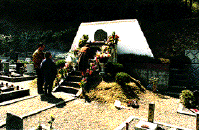 Science & Technology || Search || Back Numbers CHOICE OF EXITS:
 Gravesites reflecting more individuality are no longer a rare sight. (Photo: Kyodo) A growing number of people are specifying the kind of funeral they would like held when they die, and many are choosing nontraditional ways to mark the departure of their loved ones. The funeral industry has responded to this trend by offering a wider range of services. The high cost of traditional funerals and the shortage of cemetery space are two factors behind the phenomenon. Another, more personal reason is the longer life expectancy; people can now expect to live to around 80, and death is increasingly viewed not as an end of life but as the final part of it. Choosing One's Own Funeral An enterprise established jointly by a subsidiary of a property insurance company and a funeral home two years ago also offers contracts under which policyholders can choose their own funeral. The company holds over 5,000 such contracts today. Another twist is to actually hold one's funeral while one is alive. Such a "funeral" made headlines when it was held by a former actress a number of years ago. Predeath funerals allow the "deceased" to personally bid farewell to those assembled and to reminisce about old times, mentally preparing them to meet their end. Simply adding a personal touch to reflect the desires and profiles of the deceased can make for a more memorable ceremony. One home arranged for a live performance of the deceased's favorite classical pieces, for instance, and replaced the altar with a bookshelf for a person who was particularly fond of reading. Many people also express the wish to "return to nature," by having their ashes scattered at sea, for instance. One citizen's group first organized a scattering in the Sagami Sea in 1991 and has since conducted similar "natural funerals" for nearly 200 people. The organization has more than 3,000 members who also wish to have their ashes returned to nature. Virtual Cemeteries Another unique and popular solution, not only to the shortage of space but also to such inconveniences as having to travel to distant cemeteries, is a miniature grave containing a gravestone, altar, and mortuary tablet in a portable shrine measuring about 20 centimeters high and 20 cm across. The gravestone is made of Imari ware and has space to indicate the date and age at death and a tiny urn that can house some of the deceased's remains. The price is 150,000 yen (1,250 dollars), and it is small enough to be placed in an urban home. An even more novel solution is a virtual ceremony on the Internet. A temple in Hiroshima opened a cybergraveyard this past April that allows users to choose the type and location of the burial site free of charge. By accessing the temple's Website and registering the name, profile, and photograph of the deceased, visitors are presented with an engraved tombstone created with computer graphics. One can even sign the register of guests and offer flowers and incense by using the keyboard and mouse. The ultimate choice in the age of greater grave site options may be to not have a grave at all. Such a choice is gaining popularity as people feel that the creation of new cemeteries leads to environmental destruction. They also desire to return to the sea or mountain from where they came. Changing Values The funeral business has thus grown into a 2-trillion-yen (1.7-billion-dollar) industry with around 5,500 companies vying for customers. The cost of holding a service has escalated, moreover, with the average being around 3.8 million yen (32,000 dollars), according to a 1995 survey conducted by the Tokyo metropolitan government. The higher costs are not always justified, though. Many surviving family members want "the very best" for their deceased kin, and they allow funeral homes to tack on extraneous services. Consumers naturally find the lack of a clear pricing policy problematic, and many in the industry share this concern. The industrial association for 1,600 firms in the funeral business published a pamphlet in spring 1996 to encourage a fuller accounting of the costs incurred. "People aren't going to put up with opaque pricing much longer," a spokesperson for the association cautioned. "A lot of people are questioning the value of ceremonies that just go through the motions. People aren't simply taking what we give them; they want to choose what's best suited for them, in terms of both price and content." The nuclearization of the family and the graying of society have highlighted the problem of who will look after the traditional family grave. Dealers have appeared that promise to tend to the grave on the families' behalf on a semipermanent basis--regardless of religious affiliation or nationality. And there are "membership graves" that are shared not just with one's spouse but also with friends. People, moreover, no longer perceive a grave as a place to worship one's ancestors but as one's posthumous home. People now see death as the final chapter in the story of life and are increasingly imposing their will on how the story ends.  Edited by Japan Echo Inc. based on domestic Japanese news sources. Articles
presented here are offered for reference purposes and do not necessarily
represent the policy or views of the Japanese Government.
Edited by Japan Echo Inc. based on domestic Japanese news sources. Articles
presented here are offered for reference purposes and do not necessarily
represent the policy or views of the Japanese Government.
|
